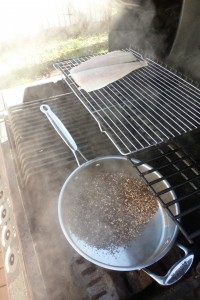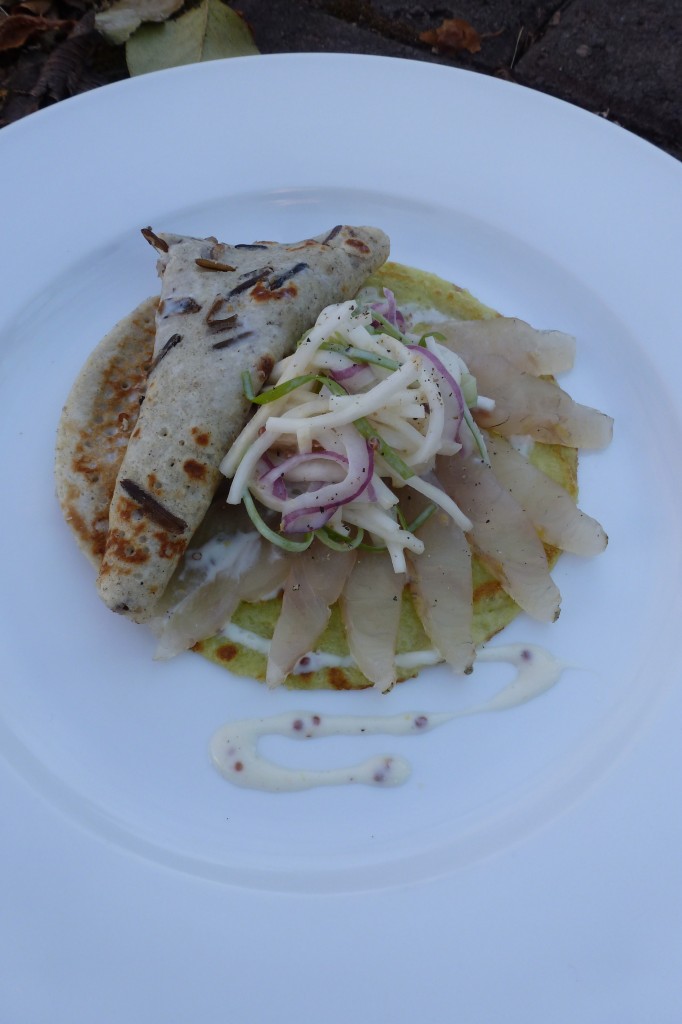 I recently picked up some pickerel from Rebekah’s Fish at the Strathcona Market and took my first stab at cold-smoking on my barbecue.
I recently picked up some pickerel from Rebekah’s Fish at the Strathcona Market and took my first stab at cold-smoking on my barbecue.
To hot-smoke on my barbecue I just remove the grate from the righthand side and put foil packets of wood chips directly onto the flames. I put the meat on the left side, which remains off. This way the meat isn’t over direct heat and will cook evenly. With the right burner on a medium-low setting, the wood chips smolder and the average temperature inside the barbecue stays around 250°F.
The point of cold-smoking is to impart the flavour of the smoke without cooking the meat. Examples of food that you might want to keep raw are cured fish, jerky, and certain types of cured meat like salami or speck. To keep the meats from cooking the temperature has to stay below 100°F. Barbecue burners are so large that no matter how low you set them, they will always produce enough heat to raise the temperature of the barbecue above 100°F.
The solution is simple enough. I ignited my wood chips in a stainless steel pan on my stove top, then put the pan in the barbecue, where I usually rest the packets. The barbecue remained off, and functioned only as a chamber to hold the smoke.
The major disadvantage of the pan method is that, without any active heat source, the chips only smoulder for about five minutes before they have to be re-ignited.
Properly curing cold-smoked meats is very important because they usually stay in the temperature “danger zone” for several hours. The danger zone, between 39°F and 140°F, represents the temperatures at which microbes grow best. Below this range they are inactive, and above this range they die. In professional kitchens they say that any food that stays in the danger zone for more than two hours is unfit to serve. When we cure meat we make the flesh inhospitable to microbes, and we can therefore keep it in the danger zone for extended periods.
Food safety aside, properly curing the fish makes the flesh firm, dense, and pleasantly salty. Below is the recipe I used to cure my pickerel, though I have to caution that I’ve found fish-curing to be a fickle business. I’ve tried the same recipe on different pieces of fish and had wildly different results.
Smoked Pickerel
adapted from Charcuterie
Ingredients
- 850 g pickerel fillet in one piece, skin on, bones removed
- 157 g kosher salt
- 63 g dark brown sugar
- 13 g crushed juniper berries
- 20 mL whiskey
Procedure
- Mix the salt, sugar, and juniper. Spread half the dry cure in a container that will just fit the fish. Lay the fish, skin side down, on the cure. Pour the whiskey over the fish, then sprinkle the remaining cure over the fish. Try to get more cure on the thicker parts of the fillet.
- Cover with plastic wrap. Rest a flat board for pan on the fish, and top with a 500 g weight. Refrigerate for 20 hours.
- Rinse the cure from the fish. Pat dry with paper towel and let rest, uncovered, on a wire rack in the fridge for at least an hour.
- Cold-smoke with maple chips until desired flavour is achieved.
I served my smoked pickerel with green pea and wild rice crêpes, and celery root slaw with grainy mustard dressing.
